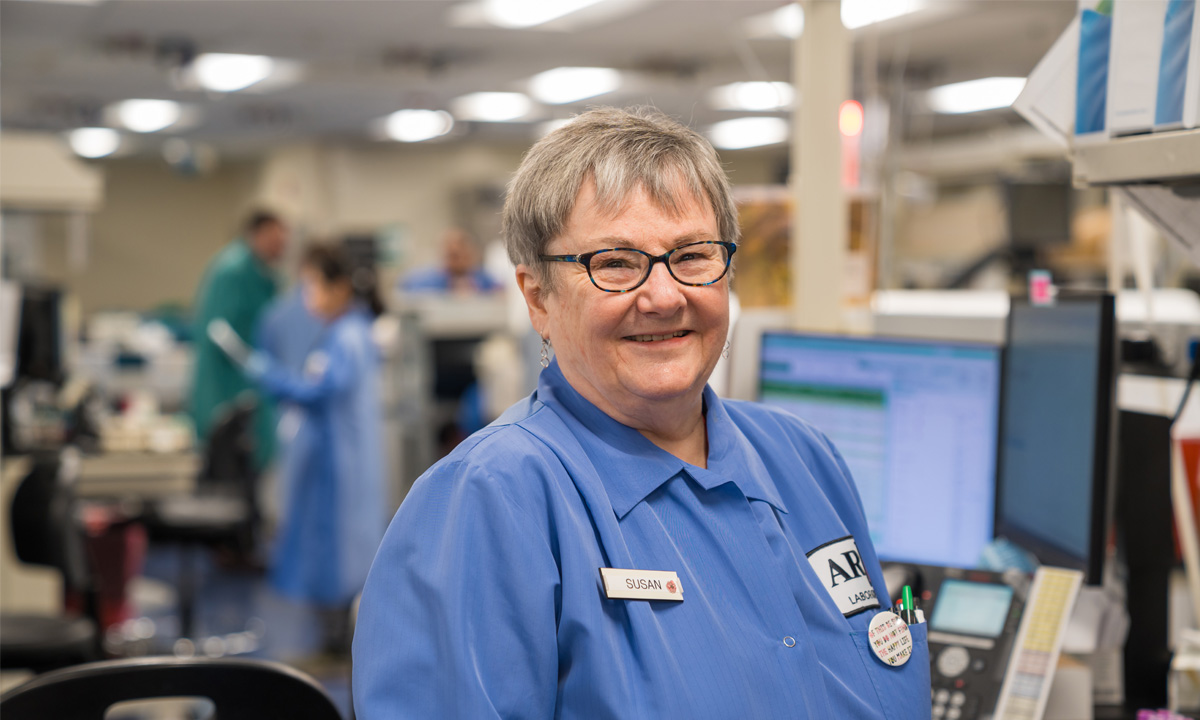
Susan Driggs, a medical laboratory scientist in ARUP’s University of Utah Hospital Clinical Laboratory, has worked in the same lab since the 1970s, before ARUP was founded.
Susan Driggs, a medical laboratory scientist at ARUP, knew she had a mind for science well before she started working at the University of Utah Hospital Clinical Laboratory. Now, more than 40 years later, she is proud to have been a scientist throughout her entire career.
For five years, Driggs worked at the University of Utah STAT lab, after which time, in 1979, she decided to take time off to care for her children. Upon her return in 1984, she was stunned to hear that her lab would soon split off from the University of Utah into a separate entity—marking the beginning of her career with ARUP at the same time the company was founded.
“It was scary. We were owned by the university, and we were a well-established institution,” Driggs said. “And these guys had the nerve to think they could establish their own company and succeed.”
It didn’t take long for Driggs to feel more confident in the new company. She continued to run testing as usual in the same hospital lab. Now, Driggs is impressed by the progress ARUP has made as a laboratory and as an employer over the years.
Driggs said that the testing she performs has changed dramatically in the last 40 years. To illustrate this progress, she described a common chemistry experiment in which students dip a wire frame in a chemical (e.g., sodium or potassium), hold it over a Bunsen burner, and identify the substance based on the color of the flame.
“Well, the instrument we were using to run sodium and potassium testing wasn’t much more sophisticated than that,” she said. “It was still flame photometry.”
Now, ARUP uses an ion-selective electrode (ISE) to detect sodium and potassium, which she said is nothing like flame photometry. These instruments can run the assays more efficiently, allowing a higher capacity for samples.
Driggs noted that along with the complexity of testing, order volumes and ARUP’s test menu have also expanded.
“When I first started, I could tell you every single test we ran in the lab, how it worked, what results meant for the patient, and how it ran on the instrument because there was a very small menu. Now, we run thousands of tests,” she said.
Driggs remembers her early days at ARUP fondly, including the time she spent with ARUP’s upper management.
“We had more interaction with our residents, management, and even the CEO. Dr. Kjeldsberg [ARUP founder and former CEO] was in and out of our lab all the time,” Driggs said. “He took the time to sit with us one-on-one at a double-headed microscope. I had the ARUP CEO teaching me the finer points of cell identification.”
Along with her positive memories of working at ARUP, Driggs recalls some challenging moments in her career, including periods of difficulties for the company, as well as public health crises.
“This is silly, but the financial scare that had the most impact on our lab was when they quit buying break room supplies. No paper plates, no forks, no cups. That was a huge blow,” she laughed. “And now, thank goodness, we have cutlery again.”
Driggs added, “It’s funny that’s what I remember. Not that we were in financial trouble. But if I forgot to bring a fork for lunch, I was out of luck.”
On a more serious note, Driggs has directly seen and felt the impact of major public health crises throughout her career. The first time she experienced a public health scare at the lab was during the HIV/AIDS epidemic. During the early days of the outbreak, Driggs and her colleagues feared they could catch the disease from handling samples.
“I was here when AIDS broke out. We didn’t know what was causing it at first. It was very scary and emotional,” she said. “In the very beginning, I didn’t know if I could get it from a tube of blood.”
Driggs said that outside of developing crises, she finds it interesting to see infectious disease trends in the samples she tests. She frequently sees results for ARUP’s respiratory panels, which inform her of the state of local public health in real time. “It is kind of exciting seeing it firsthand before it’s on the news,” she said.
After more than 40 years of working in the lab, Driggs still loves her job and wouldn’t trade it for anything else. “I could have retired, and I am semiretired. I only work two days a week,” she said. “I love having lots of free time, but I still get to come do work that I love with people I enjoy.”
“I keep threatening to quit, and I haven’t yet,” Driggs said. “But if they take the cutlery away again, I’m out of here.”
















